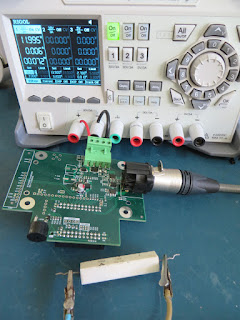Summary
This blog is the next in the series focusing on salvaging electronic parts. For this post, a Breville food processor was broken down with a view to salvage the AC motor.
 |
| Breville BFP650 |
Image courtesy www.productreview.com.au
Salvaging
There were several plastic screws and individual plastic pieces which required removal from inside the food processor which allowed the microswitches, circuit board and motor to be removed.
Microswitches
Four micro-switches from Merchant Corporation were removed from the food processor. Three of the switches were interfaced to the push buttons seen of the outside of the Breville unit and the last switch was associated with the bowl interlock switch.
 |
| Breville BFP650 Micro-switches |
Shown in the image above are the Merchant Corporation switches SM-51 and SM-31F from the Breville. The SM-31F switch features a short throw mechanical operation with a domed actuator top.
Circuit Board
The circuit board for interfacing the switches and controlling the motor is a single sided board. The switching relay manufacturer is from Tianbo Relay. There are associated passives for speed control and driving the power LED.
 |
| Breville BFP650 Control Circuit Board |
The relay is sealed at the base with a bead of clear silicone; this part could be salvaged. The two power resistors and diode may be handy for spares however parts such as the M205 fuse may not be worth salvaging.
On the solder solder side of the circuit board there is a straight forward routing layout. A noteworthy item is the use of slots in the board to address cable management. Items to avoid are the undersized pads for cables and the excess use of solder on many of the joints.
 |
| Breville BFP650 Control Circuit Board Solder Side |
AC Motor
The weight of the Breville unit appears mostly due to the copper windings of the 1000W motor. Manufactured by Chasekin Limited (HK), part number YXQ-250A33, there is no website for the company so details regarding the motor are scarce. Curiously, Breville list a 5 year warranty for the motor and all the other items have a 2 year warranty.
 |
| Breville BFP650 Motor |
To take a closer look at the motor internals the plastic cover, water catcher and mounting plate required removal.
 |
| Breville BFP650 Motor Top View |
With the mounting plate removed, the nuts holding the motor frame were visible.
 |
| Breville BFP650 Motor Mounting Plate Removed |
The motor was further disassembled by removing the cover (end bell).
 |
| Breville BFP650 Motor Assembly |
Visible in the image above is the rotor to the left, stator towards the bottom and end bell towards the top. Not pictured, but mounted on the side of the motor windings, was a thermal fuse.
The rotor was packed at the ends with a set of steel and fiber washers however no bearings were visible in the end bell. The fixture was removed and located inside was a steel bush. No bearings meant that this motor could not be used for extended periods of time.
 |
| Breville BFP650 Motor Bush |
Salvaging parts from the Breville BFP650 was a misadventure and could be considered misspent time; for this particular product the author concurs.
 |
| Breville BFP650 Hardware |
Some parts were salvaged from the Breville and the motor could be taken for metal recycling. The design and quality of the parts however, mostly prevent reuse for other purposes.































































